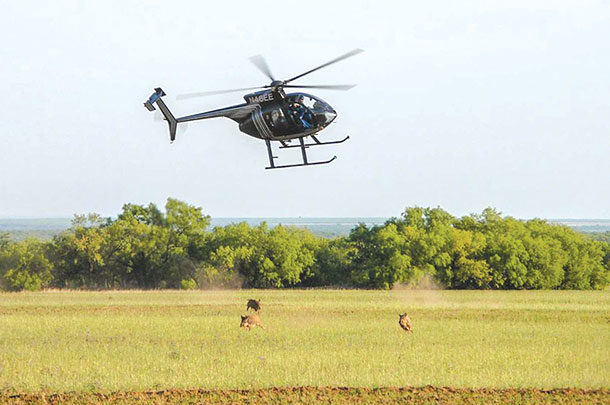Farmer and rancher success is based on the extent to which they can maintain ecosystem balance on their properties. Plants, animals and soil microorganisms must perform in concert for each other’s benefit to obtain optimal production from the land. Production capability is jeopardized when ecosystem balance is reduced or destroyed due to introduced species or shifts in existing population numbers.
An example of an introduced species degrading ecosystems is feral pigs. They uproot soil and plants, damage water quality and destroy wildlife habitat. These noxious animals can also transmit diseases such as brucellosis, E. coli and leptospirosis through contamination of feed and water sources.
Feral pigs are a distant cross between Eurasian boars imported for hunting and domesticated swine that escaped from pens or were abandoned. Rapid expansion of wild pig populations occurs because of their reproduction rates and lack of predators. Female hogs can reach sexual maturity as young as 3 to 4 months old, but most reach puberty around 7 months, having their first litter at about 1 year old. They are capable of having two litters per year that average four to six piglets. Litter size can range from one to 12 piglets, and a sow is normally productive for four to five years.
“Feral swine are very adaptable to different environments, which aids their ability to survive and multiply. They are extremely intelligent, secretive and have an acute sense of smell and good hearing, which can make them hard to locate or trap. Feral pigs are opportunist omnivores, meaning they feed on both live or dead plants and animals,” said Dr. Billy Higginbotham, professor emeritus and wildlife specialist with Texas A&M AgriLife Extension. “Eighty-five to 95 percent of their diet is vegetation, and they prefer corn and sorghum. Pigs eat 3 to 5 percent of their bodyweight daily.”
Extent of the problem
Texas is big in a lot of areas, which unfortunately includes wild pigs. Michael Bodenchuk, state director of Texas Wildlife Services, reported that Texas supports approximately one-half of the U.S. feral hog population. Population modeling indicates 6 million to 7 million wild hogs across the U.S., with over 3 million of the pests roaming the Lone Star state.
In 2016, Dr. Aaron Anderson with USDA-National Wildlife Research Center and others estimated crop damage from feral swine in 11 states at approximately $190 million. Evaluated crops included soybeans, wheat, corn, rice, peanuts and, in Texas only, sorghum or milo. Losses totaled approximately $89.9 million including $20.9 million damage to corn, $434,000 to soybeans, $20.2 million to wheat, $4.3 million to rice, $20.7 million to milo, $20.1 million damage to peanuts in Texas alone.
In 2019, Anderson and others reported on losses to livestock producers in 13 states from predation and disease cost. The economists listed approximately $17.3 million in predation losses, $9.5 million in disease-caused deaths, $7 million in other hog-related deaths, $2.6 million in hog-related veterinary costs and an additional $3.4 million in associated medical costs for a total of $39.9 million in direct costs to livestock producers. Texas Wildlife Services found that $390 in damage costs are prevented per every pig removed from the Blackland Prairie ecoregion.
Due to increased damage and disease threats by feral pigs, Congress appropriated $20 million in 2014 to USDA’s Plant Health Inspection Service (USDA-APHIS) for management of the national feral swine problem. Wildlife Services (WS) is the lead organization within APHIS that manages a wide array of damaging wildlife, including feral swine. WS works in cooperation with states, tribes, other federal agencies, universities, organizations and the public to manage feral swine populations. The organization also collaborates with Canada and Mexico on wildlife damage issues.
While annual appropriations of $20 million continued in 2019, $75 million was added over five years through the farm bill. Half of the funding was granted to USDA Natural Resources Conservation Service (USDA-NRCS) and the remainder to Wildlife Services. NRCS provides technical and financial assistance to landowners for restoration following feral hog damage. Wildlife Services provides assistance in feral swine removal.
“Prior to fiscal year 2020, approximately 28,000 to 30,000 feral hogs were removed annually. Last year, over 37,000 feral swine were removed as a result of the additional funds and extending the control effort into new areas,” said Bodenchuk.
Removal methods
“Our objective is to eradicate feral swine,” Bodenchuk continued. “On large blocks of open land, we first reduce population size by shooting from helicopters. Texas Wildlife Services owns five helicopters with four pilots, leaving one helicopter in reserve. We have trained marksmen who can kill 80 pigs per hour. Helicopters are not effective in heavy forested areas or on small blocks of land, so where hogs can be seen under woody vegetation, the pilot herds them into open areas where the marksmen have clear shots.
“Hogs are also herded from water bodies so their carcasses don’t contaminate water. Several county agricultural agents across the state work with groups of neighboring small landowners to pool their properties for creation of areas large enough for hog removal with a helicopter. Hogs are left where they fall, and then ecology takes over. Vultures and other scavengers immediately appear and devour the carcasses within hours.”
“Intent of the aerial removal program is to reduce populations to the extent eradication can be completed by trapping,” said Bodenchuk. “We have 170 professional trappers across the state to assist land managers. The trappers can provide instruction on trap construction and trapping techniques. Texas Wildlife Services also has traps for loan to land managers. In certain cases, the trappers do the trapping.”
Since the National Feral Swine Damage Management Program was initiated in fiscal year 2014, feral pigs have been eliminated in 11 states – Idaho, New York, Maine, Maryland, New Jersey, Washington, Colorado, Iowa, Minnesota, Vermont and Wisconsin. Removal efforts continue in the currently infested states.









